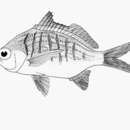Diagnostic Description
(
Inglês
)
fornecido por Fishbase
Silvery with about seven faint pinkish bars on side on body; pelvic fins yellow (Ref. 13442).
- licença
- cc-by-nc
- direitos autorais
- FishBase
- Recorder
- Grace Tolentino Pablico
Migration
(
Inglês
)
fornecido por Fishbase
Amphidromous. Refers to fishes that regularly migrate between freshwater and the sea (in both directions), but not for the purpose of breeding, as in anadromous and catadromous species. Sub-division of diadromous. Migrations should be cyclical and predictable and cover more than 100 km.Characteristic elements in amphidromy are: reproduction in fresh water, passage to sea by newly hatched larvae, a period of feeding and growing at sea usually a few months long, return to fresh water of well-grown juveniles, a further period of feeding and growing in fresh water, followed by reproduction there (Ref. 82692).
- licença
- cc-by-nc
- direitos autorais
- FishBase
Morphology
(
Inglês
)
fornecido por Fishbase
Anal spines: 3; Analsoft rays: 7
- licença
- cc-by-nc
- direitos autorais
- FishBase
- Recorder
- Grace Tolentino Pablico
Trophic Strategy
(
Inglês
)
fornecido por Fishbase
Inhabits shallow coastal waters in open sandy and surf areas, seagrass beds, near reefs, and mangrove channels (Ref. 7251). Enters brackishwater, sometimes even freshwater (Ref. 3722). May occur in small aggregations (Ref. 3722). Often seen feeding in sand patches among reefs by thrusting its mouth into the sediment and expelling sand from the gill openings (Ref. 13442). Feeds on benthic invertebrates such as worms, clams, crustaceans (Ref. 3722); Mobile invertebrates feeder (Ref. 57616).
- licença
- cc-by-nc
- direitos autorais
- FishBase
Biology
(
Inglês
)
fornecido por Fishbase
Inhabits shallow coastal waters in open sandy and surf areas, seagrass beds, near reefs, and mangrove channels (Ref. 7251). Enters brackish water, sometimes even fresh water (Ref. 3722). May occur in small aggregations (Ref. 3722). Feeds on benthic invertebrates such as worms, clams, crustaceans (Ref. 3722); also feeds on insects (Ref. 9303). Often seen feeding in sand patches among reefs by thrusting its mouth into the sediment and expelling sand from the gill openings (Ref. 13442). Easily approached (Ref. 9710). Marketed fresh but not highly esteemed; also processed into fishmeal (Ref. 3722).
- licença
- cc-by-nc
- direitos autorais
- FishBase
Importance
(
Inglês
)
fornecido por Fishbase
fisheries: minor commercial; bait: occasionally; price category: medium; price reliability: questionable: based on ex-vessel price for species in this genus
- licença
- cc-by-nc
- direitos autorais
- FishBase

